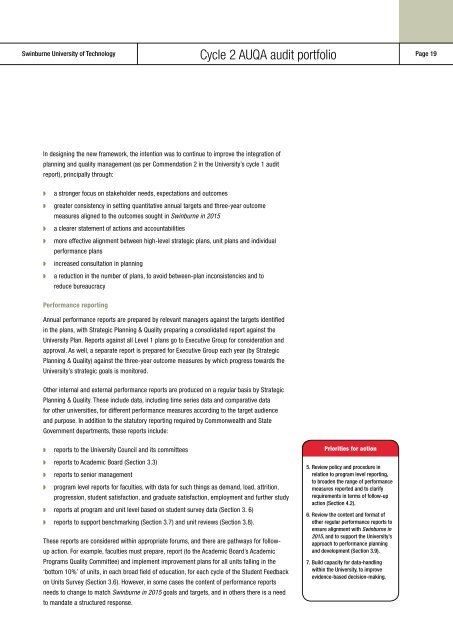pdf - Swinburne University of Technology
pdf - Swinburne University of Technology
pdf - Swinburne University of Technology
Create successful ePaper yourself
Turn your PDF publications into a flip-book with our unique Google optimized e-Paper software.
<strong>Swinburne</strong> <strong>University</strong> <strong>of</strong> <strong>Technology</strong> Cycle 2 AUQA audit portfolio Page 19<br />
In designing the new framework, the intention was to continue to improve the integration <strong>of</strong><br />
planning and quality management (as per Commendation 2 in the <strong>University</strong>’s cycle 1 audit<br />
report), principally through:<br />
w a stronger focus on stakeholder needs, expectations and outcomes<br />
w greater consistency in setting quantitative annual targets and three-year outcome<br />
measures aligned to the outcomes sought in <strong>Swinburne</strong> in 2015<br />
w a clearer statement <strong>of</strong> actions and accountabilities<br />
w more effective alignment between high-level strategic plans, unit plans and individual<br />
performance plans<br />
w increased consultation in planning<br />
w a reduction in the number <strong>of</strong> plans, to avoid between-plan inconsistencies and to<br />
reduce bureaucracy<br />
Performance reporting<br />
Annual performance reports are prepared by relevant managers against the targets identified<br />
in the plans, with Strategic Planning & Quality preparing a consolidated report against the<br />
<strong>University</strong> Plan. Reports against all Level 1 plans go to Executive Group for consideration and<br />
approval. As well, a separate report is prepared for Executive Group each year (by Strategic<br />
Planning & Quality) against the three-year outcome measures by which progress towards the<br />
<strong>University</strong>’s strategic goals is monitored.<br />
Other internal and external performance reports are produced on a regular basis by Strategic<br />
Planning & Quality. These include data, including time series data and comparative data<br />
for other universities, for different performance measures according to the target audience<br />
and purpose. In addition to the statutory reporting required by Commonwealth and State<br />
Government departments, these reports include:<br />
w reports to the <strong>University</strong> Council and its committees<br />
w reports to Academic Board (Section 3.3)<br />
w reports to senior management<br />
w program level reports for faculties, with data for such things as demand, load, attrition,<br />
progression, student satisfaction, and graduate satisfaction, employment and further study<br />
w reports at program and unit level based on student survey data (Section 3. 6)<br />
w reports to support benchmarking (Section 3.7) and unit reviews (Section 3.8).<br />
These reports are considered within appropriate forums, and there are pathways for followup<br />
action. For example, faculties must prepare, report (to the Academic Board’s Academic<br />
Programs Quality Committee) and implement improvement plans for all units falling in the<br />
‘bottom 10%’ <strong>of</strong> units, in each broad field <strong>of</strong> education, for each cycle <strong>of</strong> the Student Feedback<br />
on Units Survey (Section 3.6). However, in some cases the content <strong>of</strong> performance reports<br />
needs to change to match <strong>Swinburne</strong> in 2015 goals and targets, and in others there is a need<br />
to mandate a structured response.<br />
Priorities for action<br />
5. Review policy and procedure in<br />
relation to program level reporting,<br />
to broaden the range <strong>of</strong> performance<br />
measures reported and to clarify<br />
requirements in terms <strong>of</strong> follow-up<br />
action (Section 4.2).<br />
6. Review the content and format <strong>of</strong><br />
other regular performance reports to<br />
ensure alignment with <strong>Swinburne</strong> in<br />
2015, and to support the <strong>University</strong>’s<br />
approach to performance planning<br />
and development (Section 3.9).<br />
7. Build capacity for data-handling<br />
within the <strong>University</strong>, to improve<br />
evidence-based decision-making.

















